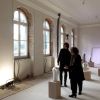“Here I stand…”
The Federal Foreign Office is supporting unusual exhibition projects in Atlanta, Los Angeles, Minneapolis and New York in the context of the Reformation Decade 2008–2017.

When Martin Luther formulated his Ninety-five Theses in 1517 he did not expect that he would go down in history one day as a man who stood by his convictions unswervingly, who struggled against corruption and the abuse of power and refused to be intimidated, even by the Pope. “Here I stand. I can do no other,” is what he is supposed to have said when opposing a revocation of his writings and defending freedom of conscience. So “Here I stand” has also been chosen as the heading for an unusual project that acknowledges Martin Luther and the anniversary of the Reformation in the form of a series of exhibitions in the United States. The project was initiated by the State Museum of Prehistory in Halle, the Luther Memorials Foundation of Saxony-Anhalt, the German Historical Museum in Berlin and the Foundation Friedenstein Castle in Gotha with support from the Federal Foreign Office. Martin Luther had an impact on world history, and today many people can trace their religious affiliation back to him, as project supervisor Tomoko Emmerling explains.
Given that there are a lot of Lutheran communities in the United States whose roots lie in Western Europe, the exhibitions aim to take them on a journey into their cultural history. To this end, the cooperation partners are sending exhibits to three museums in New York, Atlanta and Minneapolis and are anticipating large numbers of visitors, particularly in Minneapolis. “The American Midwest is Luther Country, as it were,” says Tomoko Emmerling. “More than 70% of the population have their origins in Europe, 40% of them are of German descent. Their interest in Martin Luther and in Germany is considerable.”
In the largest of the three exhibitions, covering 1,000 square meters at the Minneapolis Institute of Art, visitors can get to know the person of Martin Luther in particular. Alongside portraits of the former Augustinian monk and his wife, the former nun Katharina von Bora, archaeological finds from his parental home will hold a number of surprises. The historians have gathered children’s toys, such as marbles, remnants of festive clothing, seeds of such exotic fruits as figs, and animal bones from young pigs and venison. “In Luther’s day only princes could hunt venison, so his parents may have had contacts with higher social circles,” says project supervisor Emmerling. “It’s exciting to be able to deduce from the archaeological finds that Luther did not come from a poor family, although that is how he presented himself.”
There will also be testimonies to the Reformation in New York, where countless Europeans, including a lot of Lutherans, came ashore to start a new life in America from the 18th century onwards. For the exhibition at the Morgan Library & Museum, the curators have selected above all manuscripts and printed works by Luther. After all, the Reformation could only spread as widely and quickly as it did because a media revolution took place at the same time as Luther’s religious movement: the invention of book printing. The pearl of the New York exhibition, however, was written by Luther in ink: a letter to Emperor Charles V in which he refuses to rescind his writings against the selling of indulgences and in favour of church reform. In 2015 that document was included in the UNESCO World Documentary Heritage.
The exhibition at the Candler School of Theology at Emory University in Atlanta makes a link to the modern day. It features the largest collection of early Luther writings in the USA, while also elucidating the links between Martin Luther and the civil rights advocate Martin Luther King, who hailed from Atlanta. “His name was actually Michael King. His father visited Germany in the 1930s and later adopted the name Martin Luther King both for himself and for his son,” says Emmerling, project supervisor of “Here I stand”. “Martin Luther King himself once expressed the wish to travel to Wittenberg on the trail of his namesake.”
But American exhibition visitors in the Midwest and on the East Coast will not be the only ones to be able to gain impressions of the Reformation and of 16th century German art and culture. On the West Coast, the German exhibition organizers want to present artworks that are hundreds of years older than the American Constitution. With the support of the Federal Foreign Office, the National Museums in Berlin, the Dresden State Art Collections and the Bavarian State Collection of Paintings in Munich will present important Renaissance works at the Los Angeles County Museum of Art (LACMA) from November 2016 to March 2017. The paintings by Dürer, Cranach and Holbein are mainly intended to bring that European epoch and its extraordinary impact closer to American visitors. Michael Govan, Director of the LACMA, emphasizes that “the exhibition offers a unique opportunity in Southern California to experience the greatest achievements of German Renaissance art.” ▪
Eva Lindner
INTERACTIVE EXHIBITION
A special highlight: “Here I stand” can not only been seen in the United States or individual American cities. A section can be downloaded as a poster exhibition “#HereIstand” (in German and English) or can be ordered for schools and by anyone who would like to present a small exhibition (in German only). For more information and sample posters see:

